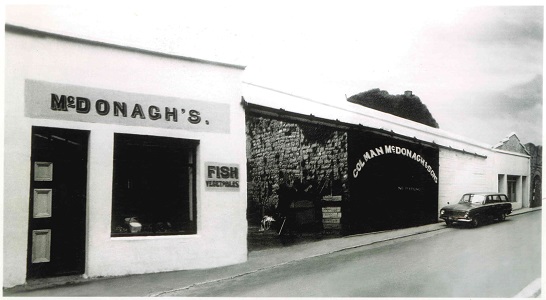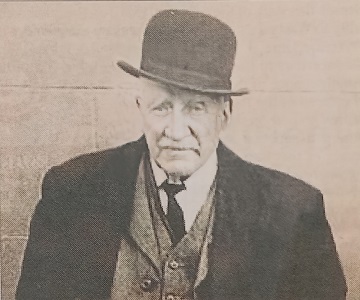McDONAGH’S, A GALWAY TREASURE

by Tom Kenny
Patrick McDonagh from Galway was born in 1817 and married Sarah Cooney. They had a son Michael who married Peggy Wallace in 1870 and they in turn had a son Colman in 1875. He had a habit of whispering in people's ears and so became known as ‘Cogar’. In 1902, he moved from Carraroe to Galway and rented stores at the back of the Spanish Arch from Peter Greene. From there, he began to sell coal, carrying it on a horse and cart.
He married Mary Joyce in 1903 and they had six children. They rented a house on Quay Street from Carrs the painters. Cogar got involved in the Nationalist movement, joined the Irish Volunteers, became a friend of Pádraic Pearse and did a lot of fundraising on behalf of Pearse's school in Dublin, St. Enda's.
In 1926, he took over an open space across the street and built a wall around it. This site had, in 1840, belonged to William Henn and later to Blakes, Jennings' and Annie Brennan. From here and his yard, he ran his coal business. When the war started, there was no coal to be had so he went back to working on the docks and, together with Paul Finn, was credited with converting dockers from being members of a British based union to being members of the Irish Transport and General Workers Union.

His son Colman (also known as 'Cogar' or Colie and seen in our photograph) married Margaret Grealish from Curraghgreen. He inherited the business and in 1948 converted the front part of the yards into two shops as you can see in our photograph. In the near shop, his wife Margaret sold fish and vegetables and the one on the other side of the gate sold bread and sweets and minerals and was run for many years by Mary Joyce. At the time Quay Street was known to locals as 'Fish Street' as many of the occupants sold fish from upturned boxes outside their doors. There was Mrs. Lynskey; Mrs. Conroy; Mary Folan who salted the fish; Mrs. Jordan; Mrs. Gill who also sold fish around Salthill; Mrs. Murphy; Mrs. Hynes who lived in the building which would later be made famous by Nora and Dilleen. In High Street, Mrs. Deacy ran a fish shop in a little stone archway and later her son Jack opened another across the street.
In 1952, a fishmonger from Quay Street was in court charged with obstruction of traffic by placing her barrels and boxes on the footpath. The case was adjourned when her solicitor said that the practice of selling fish on that street was 300 years old.
What Margaret McDonagh did that was different was to fillet the fish inside her shop and her business slowly grew. In 1962, McDonaghs began to smoke their own fish and in the 1970s began exporting. In those days, selling fish in Ireland was largely confined to one day a week - Friday.
Trends were changing, however, supermarkets began to sell fish, in France fishmongers responded by converting to seafood restaurants, in England, they became Fish & Chip shops. P.J and Mary McDonagh's (the third generation) response was to sell fruit and vegetables and wine and then, in 1982, to make cod cocktails at £1 per tub. This was very successful so they began to make chowder. One table in the fish shop became two, then three and so on. The quality of the food, the special ambience and the service wih a flah Gaulwah accint made the place a must for any lover of good seafood.
In 1993, they added a fish & chip business and a few years later they demolished the premises and replaced it with the present building. You can still hear the Galway accent there but also many other different languages as McDonagh's now has an international reputation and is run by the fourth generation.
Much of this tradition was created by Margaret who died in 1983, a legend, a woman of great charity who kept many students going on extra pieces of fish. Whenever the Poor Clare's bell rang, she put a levy on every customer, and then delivered the collected food to the sisters. She was an artist with the filleting knife, a large silver blade that flashed as she worked at great speed while dispensing recipes and advice on how to cook fish. She was particularly generous with some local characters like 'Mate' Lydon. On one of his visits, she was very busy and told him to wait at the back of the shop. He persisted but she roared at him. An American tourist enquired as to who that man was and she said, silver blade flashing, "He thinks he's the King of the Claddagh, if he annoys me again, he will soon be the Queen of the Claddagh".
